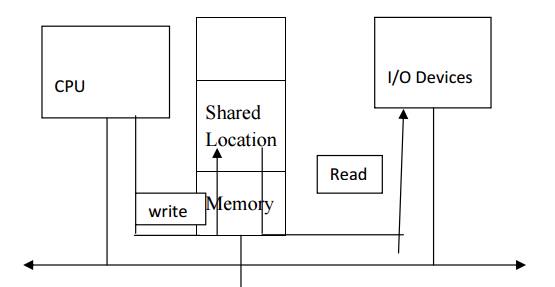Chapter: Embedded Systems
Interprocess Communication Mechanisms
INTERPROCESS COMMUNICATION MECHANISMS
1 Shared Memory Communication:

In
general, a process can send a communication in one of two ways: blocking or non
blocking. After sending a blocking communication, the process goes in to the
waiting state until it receives are sponse. Non blocking communication allows
the process to continue execution after sending the communication. Both types
of communication are useful.
There are
two major styles of inter process communication: shared memory and message
passing. The two are logically equivalent—given one, you can build an interface
that implements the other. However, some programs may be easier to write using
one rather than the other.
The input
data arrive at a constant rate and are easy to manage. But because the output
data are consumed at a variable rate, these data require an elastic buffer. The
CPU and output UART share a memory area—the CPU writes compressed characters in
to the buffer and the UART removes them as necessary to fill the serial line.
Because the number of bits in the buffer changes constantly, the compression
and transmission processes need additional size information. In this case,
coordination is simple—the CPU writes at one end of the buffer and the UART
reads at the other end. The only challenge is to make sure that the UART does
not over run the buffer instruction returns true and the location is in fact
set. The bus supports this as an atomic operation that cannot be interrupted.
Programming Example 6.1 describes a test-and-set operation in more detail.
A
test-and-set can be used to implement a semaphore, which is a language-level
synchronization construct. For the moment, let’s assume that the system
provides one semaphore that is used to guard access to a block of protected
memory. Any process that wants to access the memory must use the semaphore to
ensure that no other process is actively using it. As shown below, the semaphore names by tradition are P() to gain access to the
protected memory and V() to release
it.
/* some
non protected operations here */
P();
/*wait for semaphore */
/* do
protected work here */
V ();
/*releases ema phore */
The P ()
operation uses a test-and-set to repeatedly test a location that holds a lock
on the memory block. The P () operation does not exist until the lock is
available; once it is available, the test-and-set automatically sets the lock.
Once past the P () operation, the process can work on the protected memory
block. The V () operation resets the lock, allowing other processes access to
the region by using the P() function.
2 Message Passing
Message
passing communication complements the shared memory model. As shown in
Figure6.15, each communicating entity has its own message send/receive unit.
The message is not stored on the communications link, but rather at the
senders/ receivers at the end points. In contrast, shared memory communication
n can be seen as a memory block used as a communication device, in which all
the data a restored in the communication link/memory. Applications in which
units operate relatively autonomously are natural candidates for message
passing communication. For example, a home control system has one micro
controller per house hold device—lamp, thermostat, faucet, appliance, and so
on. The devices must communicate relatively infrequently; furthermore, their
physical separation is large enough that we would not naturally
Think of
them as sharing a central pool of memory.
Related Topics